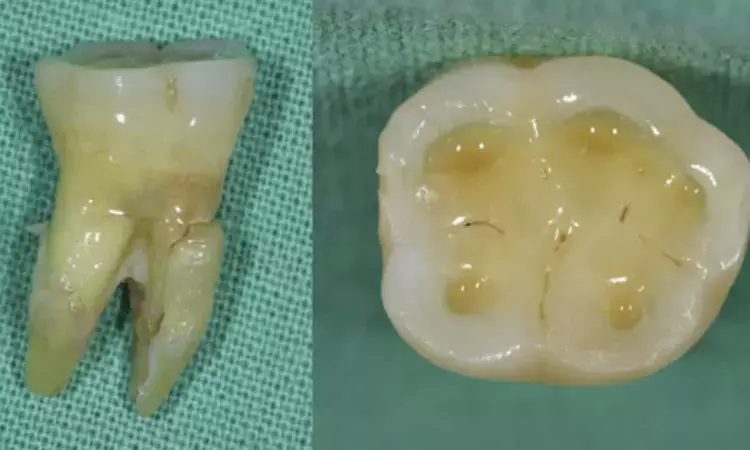- Home
- Medical news & Guidelines
- Anesthesiology
- Cardiology and CTVS
- Critical Care
- Dentistry
- Dermatology
- Diabetes and Endocrinology
- ENT
- Gastroenterology
- Medicine
- Nephrology
- Neurology
- Obstretics-Gynaecology
- Oncology
- Ophthalmology
- Orthopaedics
- Pediatrics-Neonatology
- Psychiatry
- Pulmonology
- Radiology
- Surgery
- Urology
- Laboratory Medicine
- Diet
- Nursing
- Paramedical
- Physiotherapy
- Health news
- Fact Check
- Bone Health Fact Check
- Brain Health Fact Check
- Cancer Related Fact Check
- Child Care Fact Check
- Dental and oral health fact check
- Diabetes and metabolic health fact check
- Diet and Nutrition Fact Check
- Eye and ENT Care Fact Check
- Fitness fact check
- Gut health fact check
- Heart health fact check
- Kidney health fact check
- Medical education fact check
- Men's health fact check
- Respiratory fact check
- Skin and hair care fact check
- Vaccine and Immunization fact check
- Women's health fact check
- AYUSH
- State News
- Andaman and Nicobar Islands
- Andhra Pradesh
- Arunachal Pradesh
- Assam
- Bihar
- Chandigarh
- Chattisgarh
- Dadra and Nagar Haveli
- Daman and Diu
- Delhi
- Goa
- Gujarat
- Haryana
- Himachal Pradesh
- Jammu & Kashmir
- Jharkhand
- Karnataka
- Kerala
- Ladakh
- Lakshadweep
- Madhya Pradesh
- Maharashtra
- Manipur
- Meghalaya
- Mizoram
- Nagaland
- Odisha
- Puducherry
- Punjab
- Rajasthan
- Sikkim
- Tamil Nadu
- Telangana
- Tripura
- Uttar Pradesh
- Uttrakhand
- West Bengal
- Medical Education
- Industry
Prevalence of Vertical root fractures high among endodontically treated teeth with narrow buccolingual probing depth

The prevalence of Vertical root fractures is high among endodontically treated teeth with narrow buccolingual probing depth suggests a new study published in the Journal of Endodontics.
Previous studies on the prevalence of vertical root fractures (VRFs) were based on extracted teeth, or teeth referred for apical surgery. This study examined teeth with an isolated periodontal probing depth (PD) as an indicator of VRF. The primary aim of this study was to investigate the prevalence of vertical root fracture (VRF) and non-VRF among teeth with an isolated probing depth (PD) ≥ 5 mm, the secondary aim was to assess factors associated with VRF by comparing the teeth with and without VRF in the Japanese population.
A total of 288 teeth with an isolated PD ≥ 5 mm were grouped pathologically into eight groups comprising VRF and non-VRF conditions. A descriptive analysis for age, sex, tooth type, endodontically treated teeth (ETT) versus non-ETT, proximal contacts, PD (depth), PD (broadness and location), restoration type, and presence of a post was performed. Moreover, the associations between these factors and VRFs were investigated using the Chi-square test.
Results
The prevalence of VRF was 32%. Lower first molars were the most common tooth type in both VRF (31.5%) and non-VRF groups (29.7%), while premolars were exclusively frequent in VRF (30.2%) and not frequent in non-VRF (7.8%). Narrow buccolingual PD was common in VRF (78.1%) whereas wide PD was frequent in non-VRF (67.1%). ETT, narrow buccolingual PD, tooth type (premolars), restoration type (crown), and the presence of a post showed significant associations with VRF (P ≤ .001).
VRFs may be more prevalent in ETT among the Japanese. Careful assessment is necessary to differentiate VRFs from other conditions when the lower first molars show an isolated PD ≥ 5 mm. When an endodontically treated premolar with a post shows a narrow buccolingual PD, the probability of a VRF may be greater than in other tooth types.
Reference:
Kwangsoon Lee, Manjeet Ahlowalia, Ruth Perez Alfayate, Shanon Patel, Federico Foschi. Prevalence of and factors associated with vertical root fracture in a Japanese population: an observational study on teeth with isolated periodontal probing depth. Published:September 01, 2023DOI:https://doi.org/10.1016/j.joen.2023.08.018
Keywords:
Prevalence, Vertical, root, fractures, high, among, endodontically, treated, teeth, narrow, buccolingual, probing depth, Kwangsoon Lee, Manjeet Ahluwalia, Ruth Perez Alfayate, Shanon Patel, Federico Foschi
Dr. Shravani Dali has completed her BDS from Pravara institute of medical sciences, loni. Following which she extensively worked in the healthcare sector for 2+ years. She has been actively involved in writing blogs in field of health and wellness. Currently she is pursuing her Masters of public health-health administration from Tata institute of social sciences. She can be contacted at editorial@medicaldialogues.in.
Dr Kamal Kant Kohli-MBBS, DTCD- a chest specialist with more than 30 years of practice and a flair for writing clinical articles, Dr Kamal Kant Kohli joined Medical Dialogues as a Chief Editor of Medical News. Besides writing articles, as an editor, he proofreads and verifies all the medical content published on Medical Dialogues including those coming from journals, studies,medical conferences,guidelines etc. Email: drkohli@medicaldialogues.in. Contact no. 011-43720751


